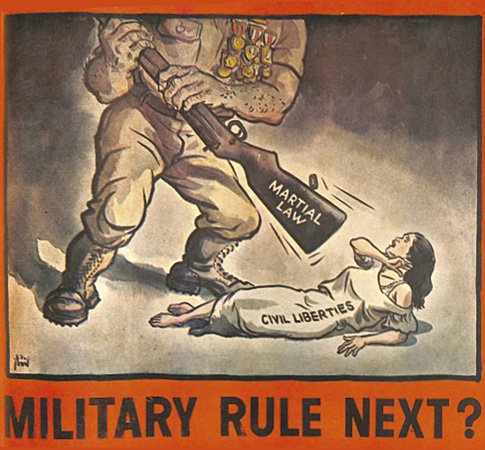Cultural Center of the Philippines
ENCYCLOPEDIA OF
PHILIPPINE ART
Military Rule Next?
22 Jul 1972 / Artist: Esmeraldo “EZ” Izon (1911 to mid-1990s) / Philippines Free Press
This postwar editorial cartoon of Esmeraldo “EZ” Izon was published in the Philippines Free Press on 22 Jul 1972, two months before the declaration of martial law on 21 Sep 1972. The Philippines Free Press at this time had been running editorials and cartoons strongly criticizing President Ferdinand Marcos’s suspension of the writ of habeas corpus and the threat of martial law. The editorial accompanying this cartoon continued the periodical’s relentless tirade against the Marcos regime by pointing out the loss of civil liberties if martial law is declared. The editorial asserted that “there would be no justice at all, no liberty at all and even less economic progress than ever.”
In this editorial cartoon, Izon personifies martial law and associates it with a rifle signifying abuse of the military. Izon utilizes synecdoche or the use of parts to represent a whole in his illustration of a military policeman about to squash the figure of civil liberties with the butt of a rifle. The viewer sees only the legs of what can be discerned as a military policeman recognizable by the tucked-in trousers and combat boots. The use of inflected lines, shadows, tonal gradations, and motion lines contributes to the filmic quality of this piece. Because editorial cartoons are single-paneled works, the ability of the cartoonist to capture the essence of the message in a brief but effective and powerful manner is very crucial. Through the use of recognizable symbols and because of the dramatic rendition, the potential ills of martial law are effectively depicted in this cartoon.
Izon also utilizes exaggeration and diminution of size to contrast martial law and civil liberties. While martial law is huge, looming like a dark and menacing shadow, civil liberties is small, dainty, and feminine. Civil liberty’s personification as a woman has its roots in the classical era in the West when liberty was personified as a goddess. It is interesting to note that in language, for instance, the term “La Liberte” is feminine. Izon harnesses this old trope but reworks the representation of a goddess into a Filipino woman with long black hair. She is shown as helpless, about to be defiled by martial law. Like the allegorical Filipinas, this image reflects women’s bodies as passive and therefore in need of defense from transgression. This gendered representation is a common trope in editorial cartoons.
Written by Helen Yu-Rivera
